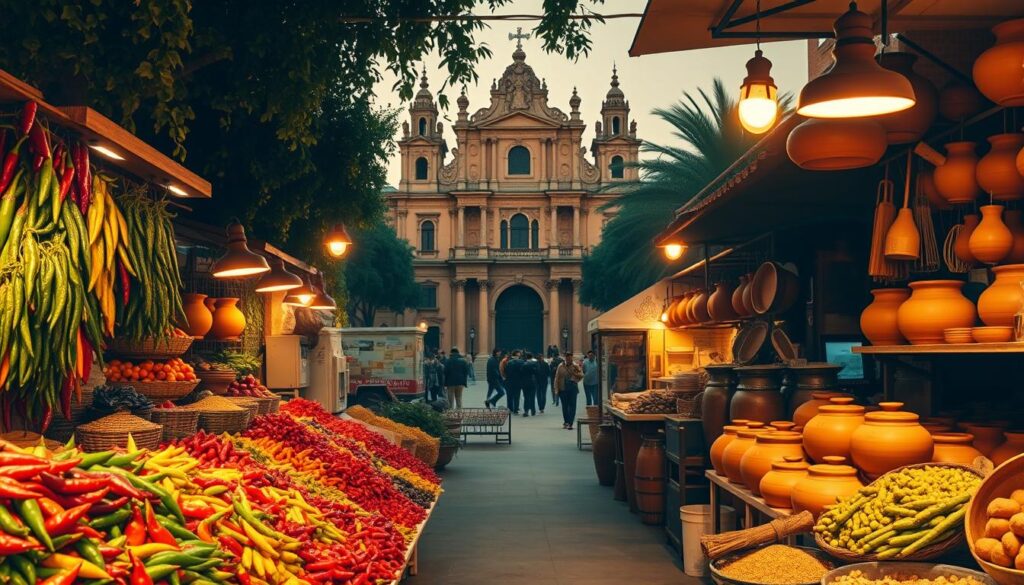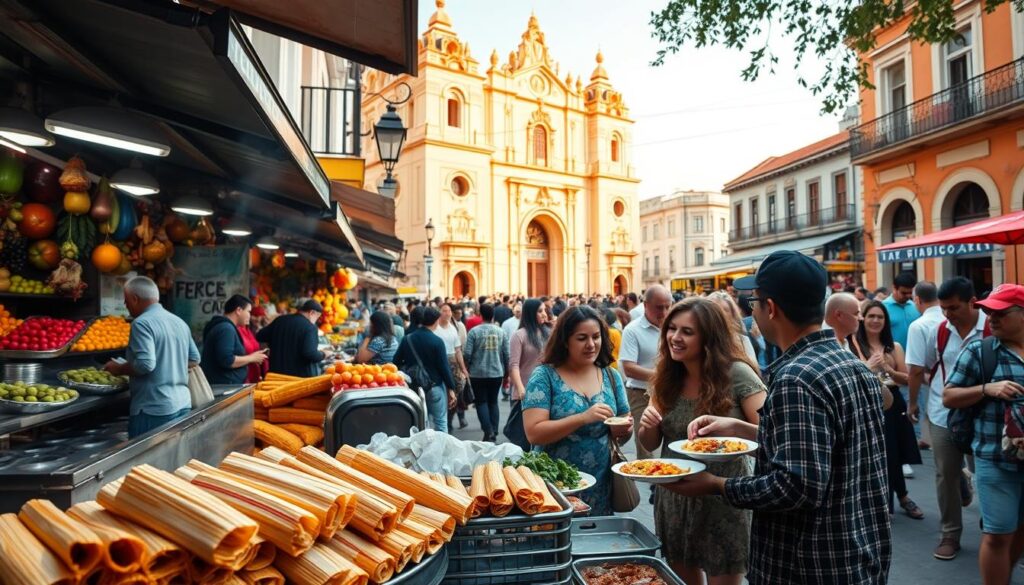Mole poblano represents Mexico’s most famous dish see Mouthwatering Dishes and it encompasses more than twenty distinct ingredients. Mole poblano demonstrates the rich complexity of the vibrant food culture found in Puebla along with its twenty or more ingredients. The region maintains a special position in history as well as food influences resulting in distinctive flavors that draw admirers from across the globe.
The culinary culture of Puebla exists as a blending point between traditional local elements and culinary traits from other nations. The culinary Mouthwatering Dishes of this city demonstrate the merging of traditions brought by Spanish colonizers along with Lebanese immigrants throughout history. In the traditional Mole poblano dish spicy chilies and sweet chocolate with savory spices fuse to form a dual flavor sauce.
Puebla presents its residents and visitors with multiple culinary Mouthwatering Dishes besides its famous mole preparation. Each traditional dish in the region displays their cultural support for local heritage through their innovative culinary practices. The food of Puebla invites sensory pleasure through its poblano pepper notes and luxurious home-made sauces.
Key Takeaways
The city of Puebla delights food enthusiasts because it features numerous tasteful culinary traditions.
Mole poblano serves as the signature dish of Puebla because it includes more than 20 different ingredients.
The region’s dishes blend native ingredients with foreign influences.
Puebla’s dining style displays characteristics that stem from its numerous periods of developmental history.
Foreign spices together with sauces function as vital elements which produce Puebla’s distinctive taste profile.
Celebrating Puebla’s Culinary Heritage

The food culture in Puebla exists today because of the historical weaving that spans multiple centuries. Traditional Pueblan cuisine results from the combination of local practices and Spanish customs with methods from convent cookery. The special combination of culinary influences has established Puebla’s vivid eating traditions which spark excitement in present-day food enthusiasts.
A Brief History of Pueblan Food
The roots of Pueblan food trace back to pre-Hispanic times. The indigenous populations of this region relied on basic food sources that continue to determine Puebla’s signature cuisine. Traditional recipes originated from these core ingredients used by Pueblan culture.
The Spanish conquest brought additional elements to the region when they settled in the territory. Traditional Pueblan cooking methods which included frying and baking combined with pork meat and dairy ingredients evolved local food Mouthwatering Dishes. The refining process of recipes and creation of famous sauces and sweets emerged from convents.
Cultural and Geographical Influences
The central location of Puebla attracted many traders since it became a vital commercial intersection where culture fused. The city of Puebla received Middle Eastern flavors alongside techniques that led to the development of cemitas. Cemitas showcase this cultural fusion through their substantial meat fillings and avocado along with cheese as main ingredients.
The physical features in this region directly influenced food preparation. The valleys offered fertile grounds for fresh vegetables and the mountaintops provided herbs together with spices. Due to the land’s cultural exchanges Puebla obtained both a diverse and distinctive culinary tradition.
Traditional Cuisine of Puebla: A Culinary Journey
The foundation of Puebla’s culinary tradition combines together historical elements and modern approach in food preparation. Through its selection of meals the region demonstrates how it maintains ancient traditions by using contemporary cooking methods. Mouthwatering Dishes Each delectable chew links to narrative about traditional Pueblan food.
| Ingredient | Use in Pueblan Mouthwatering Dishes |
|---|---|
| Ancho Chile | Adds smoky depth to mole and sauces |
| Poblano Pepper | Key in chiles en nogada and stuffed Mouthwatering Dishes |
| Pumpkin Seeds | Base for pipián sauce |
| Cacao | Essential for mole poblano |
Key Ingredients and Signature Sauces
Native chilies along with local farm produce act as essential components in creating Puebla’s traditional cuisine. The recipes benefit from nourishing depth and complexity because they integrate poblano peppers and ancho chiles. The signature sauces mole and pipián develop their unique flavors by unifying these elements together with specific spices.
Pure and well-balanced seasoning represents the distinctive property of Puebla’s signature sauces. The distinctive taste experiences of mole and pipián sauce emerge from the smoky rich mole or the nutty flavored pipián.
From Convent Recipes to Modern Plates
The traditional Mouthwatering Dishes of Puebla come directly from the kitchens established inside convents. Nuns in the region developed perfect recipes for sauces together with sweets and candies using combinations of indigenous and European cooking methods. Convent-based food preparations have developed into contemporary culinary techniques.
The traditional cooking methods of Puebla exist thanks to regional restaurants in the present day. Any innovation they introduce is done in respect to traditional culinary techniques to keep Puebla’s cuisine fresh while honoring its historical roots.
Food festivals in mexico city and beyond showcase the evolution of these Mouthwatering Dishes. Traditional medieval candy recipes from Puebla have received refined presentations that respect the culinary history of the region.
Mole Poblano and Chiles en Nogada
Mole poblano represents an exceptional culinary masterpiece. Mole Poblano sauce unites more than twenty ingredients and contains chocolate as well as chilies and spices. Consumers typically serve the dish with chicken which creates two attractive taste sensations that complement each other.
Chiles en nogada emerges as a second magnificent traditional Mexican dish. Poblano peppers receive a stuffing of meat and fruity elements and these are presented with a flavorful walnut cream sauce. The patriotic colors green white and red on the dish represent the Mexican flag thus making it a popular patriotic selection.
Other Regional Favorites
The eating establishments in Puebla present multiple culinary styles for visitors to discover. The dried chile peppers in tinga showcase how Puebla residents enjoy their strong seasoning in their food. Appearing rich from smoke defines the compositions of local cuisine to demonstrate culinary mastery throughout the city.
People who love candy will want to experience the classic taste of camotes. The traditional candied sweet potatoes have became an iconic festival food item which people treasure during special events. The city merges traditional elements with modern elements successfully.
Puebla embraces a wide variety of food from sophisticated mole to humble street food stands which provides an exciting dining experience to senses. Every dish in Puebla represents the town’s historical roots combined with cultural dynamism so food enthusiasts need to experience this culinary tradition.
Diverse Sandwiches and Street Food in Puebla
The streets of Puebla burst with numerous traditional sandwiches alongside snacks which highlight cultural traditions and regional tastes. The innovative street food sector of the region shows itself through the hearty cemitas and crispy pelonas along with other Mouthwatering Dishes. The food in Puebla presents traditional elements through innovative modern preparation techniques.
Cemitas: A Must-Try Sandwich
The cemita represents a Puebla specialty because it uses sesame-seed bread combined with savory ingredients for its distinctive filling. The sandwich made of stacked avocado and cheese and meat layers produces a fulfilling experience to the taste buds. Natural bread with nutty taste delivers an exceptional eating experience in street food markets.
This food item serves more than nourishment because it signifies the local cultural touch of this area. The specific ingredients plus preparation techniques represent Puebla’s abundant agricultural bounty as well as its culinary custom. A visitor to Mexico City must sample the cemita which can be appreciated either at market activity or quiet neighborhood spaces.
| Sandwich | Key Features |
|---|---|
| Cemitas | Sesame-seed bread, avocado, cheese, meat |
| Pelonas | Crispy bread, shredded meat, bold flavors |
| Chanclas | Soft bread, avocado, salsa, fresh ingredients |
Pelonas and Chanclas: Bold and Flavorful
The streets of Guadalajara recognize Pelonas and chanclas as popular food items among locals. Pelonas combine crisp bread with shredded meat fillings and chanclas consist of a soft texture which receives topping with avocado slices and salsa. Both Mouthwatering Dishes showcase the region’s love for bold flavors and inventive combinations.
These Mouthwatering Dishes demonstrate how sesame seeds contribute both texture and depth to the sandwiches. The combination of fresh ingredients with creamy cheese generates perfect harmony in the dish. Street food occurs in Puebla through the unique combination of traditional elements with modern creative approaches.
Cultural Significance of Street Food
A meal from Puebla street vendors represents the lively spirit of the city through its traditional and modern cultural characteristics. The vendors at Puebla prepare their dishes according to family-held recipes from the past that have protected the culinary traditions of this region. Sesame seeds and avocado within street food recipes operate as fundamental components of authentic Puebla food because they originate from local sources.
The energetic street food environment displays the results of historical trading relations and cultural assimilation between communities. Puebla street food showcases flavors that result from both Middle Eastern spice incorporation and European culinary methods. People use this event to honor both Puebla’s background story and its current transformation.
Spanish and Convent Contributions
During Spanish colonization Puebla received both new cooking practices and food materials. The techniques of frying and baking developed into standard practices and pork and dairy ingredients changed the character of local cuisine. Restaurants run by convents applied European culinary practices to indigenous food preparations.
Traditional pumpkin seed ingredients appear in Mexican sauces known as pipián. When combined with spices this ingredient demonstrates how Puebla embrace cultural changes. The convent kitchens dedicated themselves to developing sweet and saucy recipes which stay alive through contemporary dishes.
Pelonas and Chanclas: Bold and Flavorful
The streets of Guadalajara recognize Pelonas and chanclas as popular food items among locals. Pelonas combine crisp bread with shredded meat fillings and chanclas consist of a soft texture which receives topping with avocado slices and salsa. Both dishes showcase the region’s love for bold flavors and inventive combinations.
These dishes demonstrate how sesame seeds contribute both texture and depth to the sandwiches. The combination of fresh ingredients with creamy cheese generates perfect harmony in the dish. Street food occurs in Puebla through the unique combination of traditional elements with modern creative approaches.
Cultural Significance of Street Food
A meal from Puebla street vendors represents the lively spirit of the city through its traditional and modern cultural characteristics. The vendors at Puebla prepare their dishes according to family-held recipes from the past that have protected the culinary traditions of this region. Sesame seeds and avocado within street food recipes operate as fundamental components of authentic Puebla food because they originate from local sources.
The energetic street food environment displays the results of historical trading relations and cultural assimilation between communities. Puebla street food showcases flavors that result from both Middle Eastern spice incorporation and European culinary methods. People use this event to honor both Puebla’s background story and its current transformation.
Spanish and Convent Contributions
During Spanish colonization Puebla received both new cooking practices and food materials. The techniques of frying and baking developed into standard practices and pork and dairy ingredients changed the character of local cuisine. Restaurants run by convents applied European culinary practices to indigenous food preparations.
Traditional pumpkin seed ingredients appear in Mexican sauces known as pipián. When combined with spices this ingredient demonstrates how Puebla embrace cultural changes. The convent kitchens dedicated themselves to developing sweet and saucy recipes which stay alive through contemporary dishes.

Middle Eastern Inspirations in Tacos
Immigrants from the Middle East shared their traditional cuisines with Puebla which elevated the regional food repertoire. The taco fillings now feature marinated meats along with sesame seeds as direct outcomes of Middle Eastern immigration. The street food gained complexity through the introduction of new ingredients which elevated its taste profile.
As a result of cultural exchange lettuce and fresh ingredients became standard ingredients in tacos. The culinary culture of Puebla has evolved tacos into representations of its rich historical diversity. The region demonstrates a successful blending of traditions that resulted in creating its own distinctive version of foods.
Puebla serves tacos with rich smoked meat and crunchy sesame seeds to demonstrate its animated historic past. Every bite reveals how Puebla has integrated cultural elements into new and creative offerings.
Sweet Treats and Traditional Dulces Tipicos
People can explore traditional Puebla confectionery techniques which have evolved from centuries ago. These sweets surpass being sweet treats because they serve as historical artifacts which reveal the cultural heritage of this region. The various delicacies found in convents as well as markets between them share narratives about creative history and traditional customs.
Artisanal Sweets and Convent Creations
The origin of most Puebla sweets began in the kitchens of religious convents. Local ingredients allowed nuns to develop classic desserts which became camotes and tortitas de Santa Clara. These confectioneries present both delicious eating experiences and they function as foundational elements of the state’s gastronomic traditions.
The local markets feature diverse sweets that come in different flavors and textures. The culinary collection of Puebla features velvety dulce de leche alongside satisfying pepitorias so that every palate finds delight. Traditional sweets produced in Puebla typically emerge from dedicated artisan hands.
Every Puebla visitor should experience the candy stores and baking establishments within the city. These excursions present visitors with in-depth knowledge of how traditional sweets are made and the particular traditions associated with each type. The tours emphasize the cultural value of these traditional sweets because they function as both traditional desserts and as collectible items.
The eating itinerary includes popular restaurant spots combined with essential stops at food vending stands in town.
Your culinary tour of Puebla should begin at El Mural de los Poblanos which features both the traditional mole poblano and pork dishes. At Mercado de Sabores street food enthusiasts can experience the tradition of eating tlacoyos with fresh salsa on top of the corn mixture.
Experience historic La Casa de los Muñecos which serves traditional chiles en nogada presented with walnut sauce. A notable feature of Puebla cuisine lies in its distinctive combination of strong tastes with natural food elements.

Guided Tours and Culinary Classes
For an immersive journey into Puebla’s food traditions seek a professional tour. Tours through Puebla visit vibrant markets and secret locations for trying authentic pepper and cream-based dominant dishes.
Customers interested in learning can find the perfect experience through a cooking class. The traditional recipes mole and pipián teach students to build local culinary skills through interactive classes. As one chef puts it,
Preparing food stands as one of the most effective approaches to interact with different cultures.
Food exploration in Puebla goes beyond eating to deliver an authentic mexican cuisine experience. Puebla stands out for its food culture that combines an extensive past and colorful flavor spectrum.

Conclusion
Traveling through this place reveals historic tastes that extend across periods in time. Food Mouthwatering Dishes evolved through convent recipes and current street food offerings because of Puebla’s history which merged diverse culinary influences. Developmental specialties chiles en nogada and mole express that the proper time enhances their complete flavor experience.
Locals present their homemade tortillas with traditional ingredient-based desserts that provide a genuine culinary experience for diners to enjoy every morsel through tasting. Street food along with pumpkin-based sauces and the nutty richness display cultural fusion and kitchen innovations in their Mouthwatering Dishes.
Book lovers of snacks together with food fanatics find a wonderful dining experience that exists for discovery in this lively food environment. Experiencing the rich flavors allows you to discover authentic aspects of the local food culture in real conditions.



